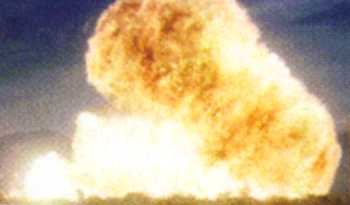| Fuel/air explosive represent
the military application of the vapor cloud explosions and dust explosions
accidents that have long bedeviled a variety of industries. And every
year, many serious explosions and fires occur in industrial plants as a
result of dust. Many materials form dust clouds that can easily ignite
and explode, injuring personnel and damaging plant. This is a well-known
phenomenon in the coal mining, grain storage, and the woodworking and paper
industries. Many miners have been killed and injured and massive production
losses have resulted from coal dust explosions in underground coal mining
operations. Of the 129 grain dust explosions that occurred nationwide between
1987 and 1997, about half involved corn. Eleven were caused by wheat dust
and 10 by dust from soybeans. Billions of tiny, highly combustible particles
of grain are generated by grain kernels rubbing together as they move along
conveyer belts and shifted between bins. Inside the enclosed chambers,
those particles rise in a cloud. When the dust gets in with the right mixture
of oxygen and comes in contact with a spark or even an overheated bearing
on a conveyer belt, it is extremely explosive. |
